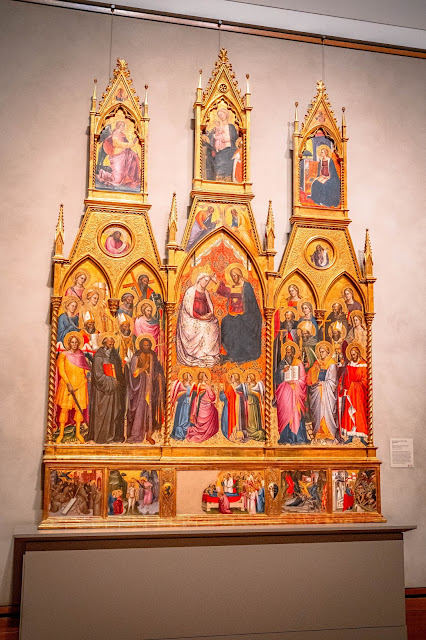The admission to The Getty Center is free but you must get a free ticket online via the website prior entry.
On-site parking is available for a fee at The Getty Center. We just park nearby and walk to The Getty Center.
Metro bus lines 734 and 234 stop at The Getty Center entrance, located at the intersection of Getty Center Drive and Sepulveda Boulevard.
There is a free tram service that takes you to The Getty Center atop.
You can pick up The GettyGuide multimedia player at the Getty Guide Desk in the Museum Entrance Hall. Just leave a photo ID with staff at the desk and collect it when you return the multimedia player.
A panaromic alpine landscape near the village of Soglio in Switzerland, visible on the right with its recognizable church tower in Val Bregaglia in southwestern Switzerland. The painting is a vivid hymn to the reawakening of nature in spring after a long, hard winter, a pantheistic work in which the landscape, the rural workers, and the animals evoke the cycle of nature.
Lidded Bowl
Porcelain: Japanese (Arita), about 1700
Mounts: French (Paris), about 1717 - 1722
Japanese porcelain decorated with patterns in blue, red, and gold was made for export to Europe and other Asian countries beginning in the late seventeenth century. In this example, the Japanese porcelain was set in silver mounts in France to form a lidded bowl with handles and a high finial that appealed to European tastes. It is made of three separate pieces of similarly decorated porcelain, a bowl and a lid formed by joining an inverted plate to the domed lid of a smaller bowl. Such assemblages demonstrate the inventiveness of French craftsmen in adapting Asian ceramics for European patrons.
BAROQUE DISPLAY
In the seventeenth century, the Italian Baroque was predominant throughout Europe. This style is characterized by richly detailed narrative compositions often with complex border decoration. Dramatic subjects from classical literature or contemporary history were represented in a highly theatrical manner meant to engage the attention and imagination of the viewer. Large-scale tapestries, furniture, and objects made of precious metals such as silver were produced in elaborate designs. Their primary function was to demonstrate the wealth and prestige of the owner through the opulence of materials and ornamentation.
Basin
Italian (Dutch or Flemish artist working in Genoa), about 1620 - 1625
Silver
Unusually large and elaborately molded, this basin served as a display piece rather than a functional vessel. The design is based on an oil sketch by the Genoese painter Bernando Strozzi. The style of the figures and animals suggests that a Dutch or Flemish silversmith, working in Genoa, translated the sketch into precious metal. In the seventeenth century, Genoa was an important center in Italy for the production of precious metalwork. This basin is the largest and among the most technically advanced known, with some figures cast almost in the round.
Saint Catherine of Alexandria and Twelve Scenes from Her Life, about 1330 by Donato and Gregorio D'Arezzo
Tempera and gold leaf on panel
According to the writings of some medieval theologians, one of painting's key purposes was to illustrate sacred texts to the largely illiterate population. This panel fulfills that aim, portraying the legend of Catherine of Alexandria in a dozen scenes. In fact, a painting of the Virgin and Child inspired Catherine's own conversion to Christianity, that event's depiction (at left) is a fitting demonstration of the instructive powers of medieval images.
Compound Microscope and Case
French (Paris), about 1751
Microscope: Gilt bronze; enamed; shagreen; glass
Case: Wood; tooled and gilded leather; brass; interior lined with velvet, silver braid, and lace
Decorative microscopes were made for the wealthy intelligentsia of Paris, who had a passion for the study of natural history and who maintained collections of all sorts of natural specimens, such as shells, fossils, minerals, bottles of preserved animals and insects, and a variety of stuffed exotic animals including armadillos and crocodiles.
The microscope still works, and the case is fitted with a drawer filled with the necessary attachments such as tweezers, extra lenses, and slides of such items as geranium petals, hair, fly wings, and fleas. Some of the slides are from the 1800s, indicating that the instrument was in continual use for over a century.
With attachments such as an ocular micrometer, the microscope incorporates the latest scientific technology of the mid-1700s. The design of its curving gilt bronze stand was the height of the Rococo style when it was created.
The Annunciation, about 1333 - 1334 by Giovanni di Balduccio
Sculpture
The Annunciation depicts the moment that the archangel Gabriel announces to the Virgin Mary that she will become the mother of Jesus. Gabriel is slightly smaller than the Virgin Mary, he looks at her with his head turned slightly to his left, his right knee bent underneath is tunic. His hair flows backward, indicating his sudden arrival and Mary seemingly surprised, returns his gaze, her head slightly turned toward her right. She rests on her right leg, bending the left knee, while she gathers the tail of her long cloak.
Writing Desk, 1760 by Abraham Roentgen
German
Oak and fir veneered with walnut, tulipwood, rosewood, cherry, boxwood, cedrela, ebony, and ivory; gilt-bronze mounts; brass hinges and stringing; iron locks and hardware.
One pair of lidded and mounted bowls by Wolfgang Howzer
Porcelain (Japanese) about 1660 - 1680; Mounts (English) about 1680
Porcelain and underglaze blue decoration; gilt-bronze mounts
This pair of lidded bowls was assembled in London, perhaps for a sophisticated member of the court of Charles II.
Corner Cupboard (left corner), about 1744 - 1755; clock dial 1744
French (Paris)
Cabinet by Jacques Dubois
Clock Movement by Etienne Le Noir II
Clock Dial enameled by Antoine-Nicolas Martiniere
Design for the cabinet by Nicolas Pineau
White oak, and mahogany veneered with bloodwood, kingwood, ferreol, amaranth, and mahogany; enameled metal clock dial; glass; glit-bronze mounts; brass and iron hardware and lock; restorations in fir, walnut, and Andaman padauk
The cabinet was actually made for a Polish general, Count Jan Klemens Branicki. An inventory of his possessions made at his death describes both the corner cupboard and the objects displayed on its shelves; a collection of mounted Chinese porcelain and clocks, some embellished with porcelain flowers. Drawings and engravings were sources frequently used by foreign patrons and craftsmen to order and copy the latest fashions in French interior design.
The Coronation of the Virgin with Saints, about 1390s by Cenni di Francesco
Tempera and gold leaf on panel
Central panel: In the central panel of this opulent polyptych, Christ crowns his mother, the Virgin Mary, as gathered angels and saints look on. The altarpiece decorated a chapel dedicated to Saint Benedict in the Church of Santa Trinita, Florence, which explains why Saint Benedict is portrayed twice, on the left panel and again in a scene below.
Above the central scene: In the pinnacles above the central scene, which were added at a later date, the Archangel Gabriel announces the conception of Christ to the Virgin.
Below in the predella (Lowest panel): The Virgin's death is represented at the center. To either sides are scenes of saints triumphing over evil. On the far left, Saint Benedict exorcises a devil; and in the panel to the right Saint John baptizes Christ. To the right of the Virgin's death, devils torment Saint Anthony; while on the far right Saint Lawrence liberates a soul from purgatory.
The Temptation of Saint Anthony, 1570s by Lelio Orsi
Oil on canvas
An early Christian monk, Anthony (about 251-356) distributed his property to the poor and then withdrew to the Egyptian desert to contemplate God in solitude. During his fifteen-year retreat, he began his legendary combat against the devil, withstanding a series of horrific and seductive visionary temptations. Here Saint Anthony is besieged by demons emerging from the darkness. His triumphant resistance to evil is communicated by his heroic figure, calm concentration on his book, and radiance.
Allegory of Salvation with the Virgin and Christ Child, St. Elizabeth, the Young St. John the Baptist, and Two Angels, about 1521 by Rosso Fiorentino
Oil on panel
Double Head, about 1543 by Francesco Primatticcio
Bronze
This intriguing sculpture was cast from the female head of the ancient marble statue Cesi Juno (Rome, Capitoline Museum), which Michelangelo described as the most beautiful object in Rome. It may be one of the bronze casts after antique Roman statues that the French king Francis I commissioned from Primaticcio, his court artist, for the palace of Fontainebleau, outside Paris. The sculpture may have been conceived as an homage to the Duchesse d'Etampes, Francois I's mistress, whose full name was Anne de Pisseleu d'Heilly.
Knowing the history and story behind each art is incredibly interesting. Without noticing the time, we spent half a day here and we haven't even finish touring all four pavilion. Decided to call it a day because we were super duper hungry so we went to
Kang Ho Dong Baekjeong for dinner which is near our Airbnb.

















































Comments
Post a Comment